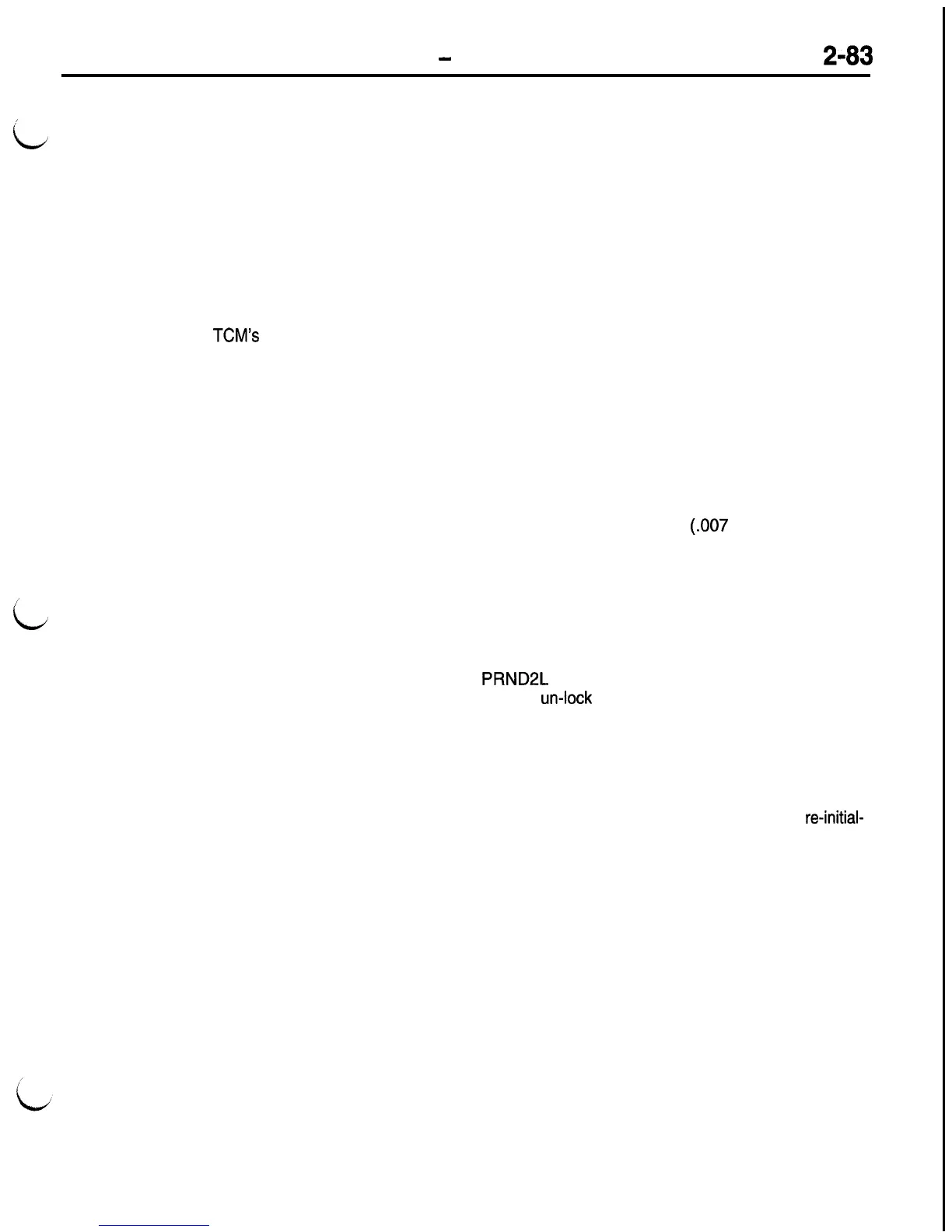POWER TRAIN
-
Automatic Transaxle
2-83
TRANSMISSION CONTROL MODULE OPERATION
:
L
Introduction
What does it do and how does it know? You have
probably asked yourself this question more than
once as you pondered some transaxle problems.
This is really a very complex question. Just stop
and think about it for a minute. Think of all the
electronic logic features that have to be programmed
into this small control module so that it will always
know just what clutch to apply and release, at just
the right time, under all the different driving condi-
tions that could possibly take place.
A description of the
TCM’s
electronic functions can
be simplified if we look at them, one main logic
function at a time. We will use this “logic function”
approach to describe in simple terms how the TCM
makes some of these complex decisions. We will
TCM Routine and Logic Functions
Many of the control logic functions discussed in
this section rely on output information from a prior
logic function as their main input information. This
should be kept in mind when you are doing your
diagnosis. Most of these logic functions are recalcu-
lated and updated on a regular basis and in a specific
/
Start Routine
Li
The first function the TCM performs, when the igni-
tion key is turned on, is the Start Routine. This
routine allows the TCM to check critical inputs and
memory circuits before it powers-up the system.
If everything is ok up to and including the switched
battery tests to the TCM and pressure switches,
then the TCM will power-up the transmission control
relay and finish the remaining checks as described
below.
The Start Routine is performed when the ighition
switch is turned to the OFF (column unlock) or RUN
positions and again when the ignition switch is re-
turned to the run position after engine cranking.
concentrate on the main logic functions and define
the primary input and output requirements. By doing
this we will be able to use simple block diagrams,
charts and graphs to illustrate how some of the
decisions are made. We will not cover electronically
how the actual logic circuits inside the TCM work.
The main logic functions, covered in this lesson,
include the Start Routine, Transmission Range and
Park Neutral Position Switch Logic, Shift Lever Posi-
tion Logic, Speed Sensor Logic, Transaxle Tempera-
ture, Shift Schedule Logic, Torque Converter EMCC
Logic, Shift Selection Logic, Shift Execution Logic,
Solenoid Switch Valve Control Logic, Clutch Apply
Status (Clutch Volume Tracking), Normal Shutdown
Routine, Fail-Safe Routine.
sequence. This sequence and the time interval that
it takes to complete these normal functions is re-
ferred to as a program loop. A program loop occurs
once every 7 milliseconds
(.007
seconds). Some
special checks or logic functions may be performed
more or less frequently.
NOTE
The ignition switch has been redesigned to allow
for power up of the TCM, BCM and electronic
PRND2L
display. This occurs with the key in the
column
unlock
position, just before the ignition run
position.
Any invalid result sets the appropriate diagnostic
trouble code, and the system immediately goes into
limp-in. The TCM identifies the crank period by the
crank signal input provided at pin 8. When the crank
signal is present, the TCM is stopped and is
re-initial-
ized after cranking to eliminate the possibility of
low cranking voltages or spikes confusing the Cen-
tral Processing Unit (CPU). The CPU is a small
microprocessor inside the TCM that contains thou-
sands of transistors and diodes on a chip of silicone
small enough to fit on the tip of your finger.
